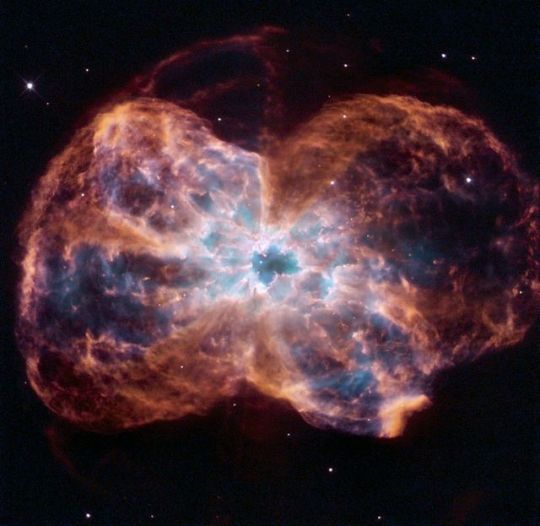#Planetary Nebula NGC 2440
Photo
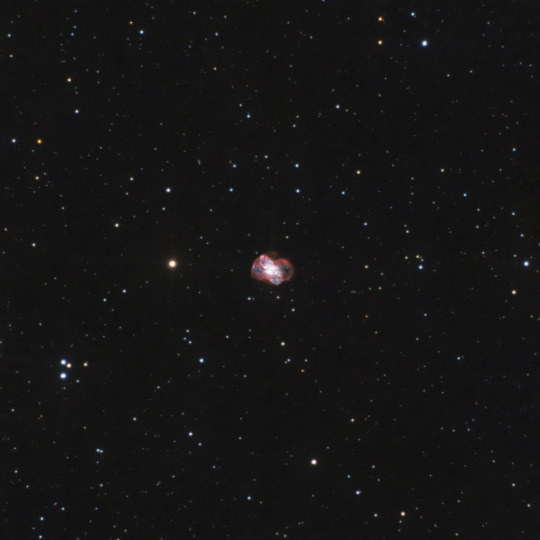
The Bow Nebula, NGC 2440 // Dionysus
48 notes
·
View notes
Photo
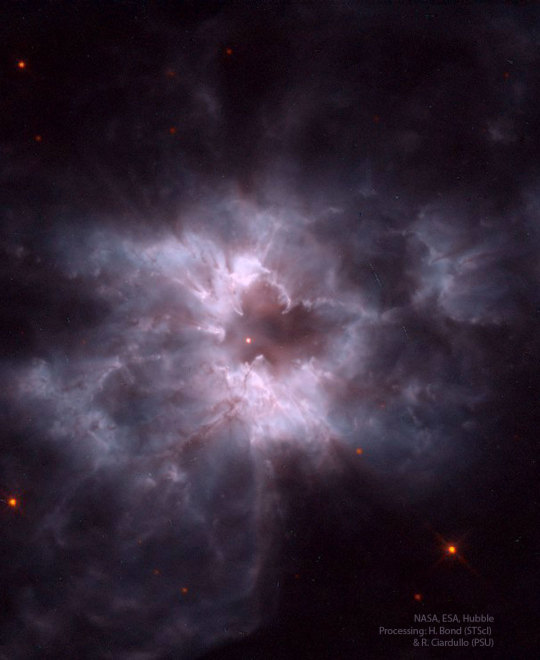
2023 December 24
NGC 2440: Cocoon of a New White Dwarf
Image Credit: NASA, ESA, Hubble; Processing: H. Bond (STScI), R. Ciardullo (PSU), Forrest Hamilton (STScI)
Explanation: What's that in the center? Like a butterfly, a white dwarf star begins its life by casting off a cocoon of gas that enclosed its former self. In this analogy, however, the Sun would be a caterpillar and the ejected shell of gas would become the prettiest cocoon of all. In the featured cocoon, the planetary nebula designated NGC 2440 contains one of the hottest white dwarf stars known. The white dwarf can be seen as the bright orange dot near the image center. Our Sun will eventually become a white dwarf butterfly, but not for another 5 billion years.
∞ Source: apod.nasa.gov/apod/ap231224.html
232 notes
·
View notes
Text
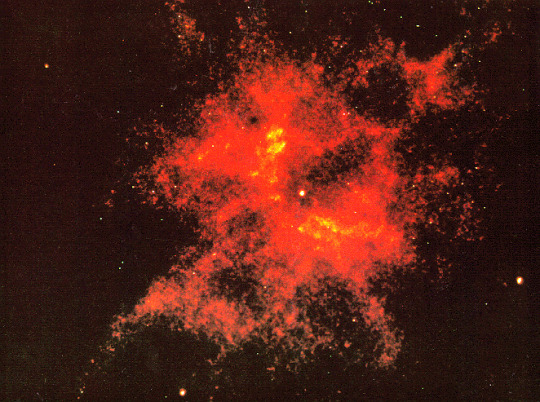
NGC 2440 Nucleus: The Hottest Star? - November 30th, 1995.
"In the center of the above photograph lies a star with one of the hottest surface temperatures confirmed. This bright white dwarf star's surface has been measured at greater than 200,000 degrees Celsius - more than 30 times hotter than that of our own Sun. The white dwarf's extreme heat makes it glow extraordinarily bright: intrinsically more than 250 times brighter than the Sun. The star is at the center of the planetary nebula titled NGC 2440, which lies inside our Milky Way galaxy. The above computer sharpened image was taken by the Hubble Space Telescope."
46 notes
·
View notes
Text

NGC 2440: Cocoon of a New White Dwarf!
What's that in the center? Like a butterfly, a white dwarf star begins its life by casting off a cocoon of gas that enclosed its former self.
In this analogy, however, the Sun would be a caterpillar and the ejected shell of gas would become the prettiest cocoon of all. In the featured cocoon, the planetary nebula designated NGC 2440 contains one of the hottest white dwarf stars known.
The white dwarf can be seen as the bright orange dot near the image center.
Our Sun will eventually become a white dwarf butterfly, but not for another 5 billion years
Image Credit: NASA, ESA, Hubble; Processing: H. Bond (STScI), R. Ciardullo (PSU), Forrest Hamilton (STScI)
#art#cosmos#cosmic#universe#blast#space#photography#stars#nasa#NGC 2440#cocoon#dwarf#esa#hubblr#magic#surreal#butterfly#white dwarf
43 notes
·
View notes
Text
.6 de Febrero.
Planetary nebula NGC 2440 is a relic of a star once like our Sun that has cast off its outer layers of gas, forming a colorful cocoon around the star's remaining core.
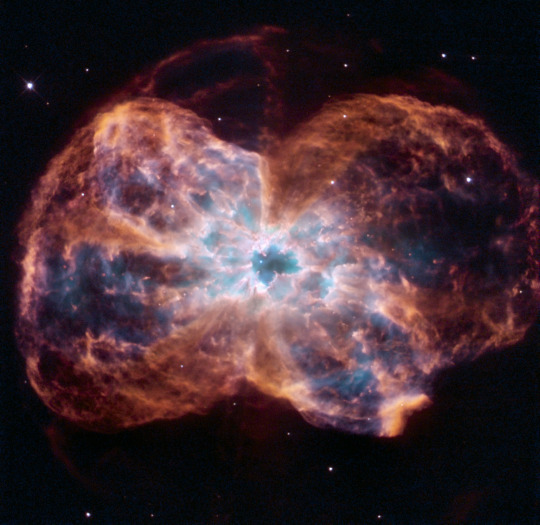
.Esto ocurría muy, muy lejos de casa cuando nos conocimos.
.23 de Febrero.
Hubble examined this part of the sky, located near the Big Dipper and called the GOODS-North field, as part of the Great Observatories Origins Deep Survey (GOODS).

.Así de hermoso se veía el universo la noche que empezó todo.
6 notes
·
View notes
Text

APOD December 24, 2023
NGC 2440: Cocoon of a New White Dwarf
What's that in the center? Like a butterfly, a white dwarf star begins its life by casting off a cocoon of gas that enclosed its former self. In this analogy, however, the Sun would be a caterpillar and the ejected shell of gas would become the prettiest cocoon of all. In the featured cocoon, the planetary nebula designated NGC 2440 contains one of the hottest white dwarf stars known. The white dwarf can be seen as the bright orange dot near the image center. Our Sun will eventually become a white dwarf butterfly, but not for another 5 billion years.
0 notes
Photo

Planetary Nebula NGC 2440 taken on February 6 in 2007
#planetary nebula ngc 2440#nebula#nebula ngc 2440#galaxy#galaxies#astronomy#astronomy pictures#astronomy photos#astronomy blog#nasa#nasa pictures#nasa photos#aesthetic#universe#space#stars#milky way#lights#tumblr#colors#palette#hubble space telescope#nasa telescope#constellations#february 6#2007#2021#where the skies end
55 notes
·
View notes
Photo

(ESA/Hubble) NGC 2440
NGC 2440 is another planetary nebula ejected by a dying star, but it has a much more chaotic structure than NGC 2346. The central star of NGC 2440 is one of the hottest known, with a surface temperature near 200,000 degrees Celsius. The complex structure of the surrounding nebula suggests to some astronomers that there have been periodic oppositely directed outflows from the central star, somewhat similar to that in NGC 2346, but in the case of NGC 2440 these outflows have been episodic, and in different directions during each episode. The nebula is also rich in clouds of dust, some of which form long, dark streaks pointing away from the central star. In addition to the bright nebula, which glows because of fluorescence due to ultraviolet radiation from the hot star, NGC 2440 is surrounded by a much larger cloud of cooler gas which is invisible in ordinary light but can be detected with infrared telescopes. NGC 2440 lies about 4,000 light-years from Earth in the direction of the constellation Puppis.
The Hubble Heritage team made this image from observations of NGC 2440 acquired by Howard Bond (STScI) and Robin Ciardullo (Penn State).
Credit: NASA/ESA and The Hubble Heritage Team (AURA/STScI).
About the Object
Name: NGC 2440
Type: Milky Way : Nebula : Type : Planetary
Distance: 4000 light years
Constellation: Puppis
Coordinates
Position (RA): 7 41 55.31
Position (Dec): -18° 12' 30.96"
Field of view: 0.49 x 0.49 arcminutes
Orientation: North is 6.7° left of vertical

Source
1 note
·
View note
Photo

Planetary Nebula NGC 2440
#Planetary Nebula#NGC 2440#nasa#stargazing#astrophoto#astrophotography#galaxy#astronomy#universe#space#nebula#spinningblueball#milky way#milky way galaxy#star
227 notes
·
View notes
Photo
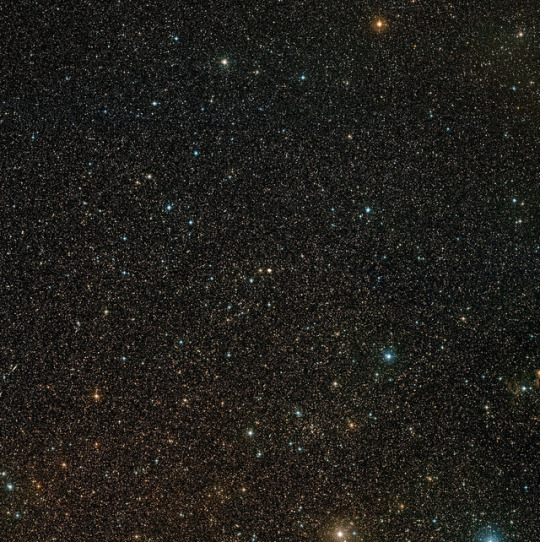
Wide-Field Nebula
76 notes
·
View notes
Photo

Planetary Nebula NGC 2440 by Hubble Heritage
203 notes
·
View notes
Photo

JOHNS HOPKINS ASTROPHYSICISTS OBSERVE LONG-THEORIZED QUANTUM PHENOMENA At the heart of every white dwarf star -- the dense stellar object that remains after a star has burned away its fuel reserve of gases as it nears the end of its life cycle -- lies a quantum conundrum: as white dwarfs add mass, they shrink in size, until they become so small and tightly compacted that they cannot sustain themselves, collapsing into a neutron star. This puzzling relationship between a white dwarf’s mass and size -- called the mass-radius relation -- was first theorized by Nobel Prize-winning astrophysicist Subrahmanyan Chandrasekhar in the 1930s. Now, a team of Johns Hopkins astrophysicists has developed a method to observe the phenomenon itself using astronomical data collected by the Sloan Digital Sky Survey and a recent dataset released by the Gaia Space Observatory. The combined datasets provided more than 3,000 white dwarfs for the team to study. A report of their findings, led by Hopkins senior Vedant Chandra, is now in press in the Astrophysical Journal and available online on arXiv. “The mass-radius relation is a spectacular combination of quantum mechanics and gravity, but it’s counterintuitive for us -- we think that as an object gains mass, it should get bigger,” says Nadia Zakamska, an associate professor in the Department of Physics and Astronomy who supervised the student researchers. “The theory has existed for a long time, but what’s notable is that the dataset we used is of unprecedented size and unprecedented accuracy. These measurement methods, which in some cases were developed years ago, all of a sudden work so much better and these old theories can finally be probed.” The team obtained their results using a combination of measurements, including primarily the gravitational redshift effect, which is the change of wavelengths of light from blue to red as light moves away from an object. It is a direct result of Einstein’s general theory of relativity. “To me, the beauty of this work is that we all learn these theories about how light will be affected by gravity in school and in textbooks, but now we actually see that relationship in the stars themselves,” says fifth-year graduate student Hsiang-Chih Hwang, who proposed the study and first recognized the gravitational redshift effect in the data. The team also had to account for how a star’s movement through space might affect the perception of its gravitational redshift. Similar to how a fire engine siren changes pitch according to its movement in relation to the person listening, light frequencies also change depending on movement of the light-emitting object in relation to the observer. This is called the Doppler effect, and is essentially a distracting “noise” that complicates the measurement of the gravitational redshift effect, says study contributor Sihao Cheng, a fourth-year graduate student. To account for the variations caused by the Doppler effect, the team classified white dwarfs in their sample set by radius. They then averaged the redshifts of stars of a similar size, effectively determining that no matter where a star itself is located or where it’s moving in relation to Earth, it can be expected to have an intrinsic gravitational redshift of a certain value. Think of it as taking an average measurement of all the pitches of all fire engines moving around in a given area at a given time -- you can expect that any fire engine, no matter which direction it’s moving, will have an intrinsic pitch of that average value. These intrinsic gravitational redshift values can be used to study stars that are observed in future datasets. The researchers say that upcoming datasets that are larger and more accurate will allow for further fine-tuning of their measurements, and that this data may contribute to the future analysis of white dwarf chemical composition. They also say their study represents an exciting advance from theory to observed phenomena. “Because the star gets smaller as it gets more massive, the gravitational redshift effect also grows with mass,” Zakamska says. “And this is a bit easier to comprehend -- it’s easier to get out of a less dense, bigger object than it is to get out of a more massive, more compact object. And that’s exactly what we saw in the data.” The team is even finding captive audiences for their research at home -- where they’ve conducted their work amid the coronavirus pandemic. “The way I extolled it to my granddad is, you’re basically seeing quantum mechanics and Einstein’s theory of general relativity coming together to produce this result,” Chandra says. “He was very excited when I put it that way.” IMAGE....Planetary nebula NGC 2440's central star, HD62166, is possibly the hottest known white dwarf star discovered yet. White dwarfs exhibit puzzling quantum phenomena: As they gain mass, they shrink in size.
12 notes
·
View notes
Photo

Astrophysicists observe long-theorized quantum phenomena
At the heart of every white dwarf star—the dense stellar object that remains after a star has burned away its fuel reserve of gases as it nears the end of its life cycle—lies a quantum conundrum: as white dwarfs add mass, they shrink in size, until they become so small and tightly compacted that they cannot sustain themselves, collapsing into a neutron star.
This puzzling relationship between a white dwarf's mass and size, called the mass-radius relation, was first theorized by Nobel Prize-winning astrophysicist Subrahmanyan Chandrasekhar in the 1930s. Now, a team of Johns Hopkins astrophysicists has developed a method to observe the phenomenon itself using astronomical data collected by the Sloan Digital Sky Survey and a recent dataset released by the Gaia Space Observatory. The combined datasets provided more than 3,000 white dwarfs for the team to study.
A report of their findings, led by Hopkins senior Vedant Chandra, is now in press in Astrophysical Journal and available online on arXiv.
Image: Planetary nebula NGC 2440's central star, HD62166, is possibly the hottest known white dwarf star discovered yet. White dwarfs exhibit puzzling quantum phenomena: As they gain mass, they shrink in size.
Credit: PIXABAY
11 notes
·
View notes
Photo
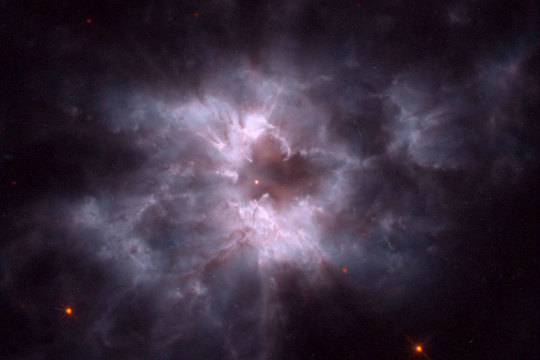
Stars Dying Endlessly - The Fate of our Sun.
This is the way the world ends. Not with a bang, but as a cinder. In the three seconds it would take you to read that parody of T.S. Eliot, our Sun will transmute some 2.1 billion tons of hydrogen into helium. In the process, 14.7 million tons of matter simply vanish, directly becoming the energy that, among other things, makes life possible on planet Earth. In the 20th century alone, the Sun's core lost 15.5 quadrillion - 15,500,000,000,000,000 - tons of matter.
The Sun has been consuming itself in this fashion for the past five billion years, burning hydrogen to produce the radiation pressure needed to counteract the relentless inward pull of its own gravity. Despite this enormous rate of fuel consumption, astronomers believe the Sun has enough hydrogen left in its core to remain a relatively stable main sequence star for another seven billion years.
But as the Sun's core loses mass, its temperature and density must increase to maintain hydrogen equilibrium. When the Sun was an infant it was slightly smaller, cooler, and dimmer than it is today. As its rate of nuclear fusion slowly increases in the eons ahead, it will continue to expand and more energy will radiate from it. In other words, our Sun will get brighter. That’s not an immediate problem for a star. But it's a death sentence for planet Earth.
Over the next several hundred million years, the Sun's increasing temperature will accelerate the evaporation of Earth's oceans, driving up the opacity of our atmosphere and eventually triggering a runaway greenhouse effect. Ultraviolet radiation will break down the water molecules in our atmosphere and the component hydrogen in H2O will escape into space. Earth will begin to resemble Venus.
Within a little more than one billion years, Earth's once teeming oceans will disappear as surface temperatures soar above the boiling point of water, turning a once-verdant world into a lifeless, burned-out cinder. Still, our slowly brightening Sun will remain on the main sequence for some six billion years beyond Earth's hellish demise, before finally exhausting the hydrogen in its core. At that point, the core's proton-proton chain of fusion reactions will stop, the radiation pressure that supports the star's overlying layers will suddenly drop, and the core will collapse due to the force of gravity. Hydrogen in a shell around the core will continue burning, but the core's collapse will heat this shell and cause it to expand. As the radius of the Sun grows, its surface temperature will consequently drop off. But the Sun's luminosity, the rate at which energy radiates from a star, will increase dramatically and the Sun will become a bloated red giant.
The effect as viewed from an orbiting planet - could any one survive to see it - would be awesome. Reddish and bloated, it will appear 50 degrees across in the Earth's sky, quadruple the angular size of Orion and (if we ignore the inevitable slowing of terrestrial rotation) will take over three hours to rise and set. The Sun's core - now only planet size - has a temperature of nearly 90 million degrees Fahrenheit. It resists further compression not by fusion but by a quantum mechanical effect known as degenerate gas pressure, in which electrons with identical properties cannot be crammed closer together. Eventually, gravitational contraction pushes temperatures high enough to trigger the fusion of helium nuclei into carbon.
Because the core is degenerate gas, this temperature increase does not immediately cause the core to expand. Instead, it causes the rate at which helium is converted into carbon to accelerate in a burst called a helium flash. Eventually, core temperatures reach more than 600 million degrees, the electrons become "non-degenerate" and the core expands and cools off a bit as helium transforms into carbon. Hydrogen burning continues in a shell around the helium-burning core.
But the helium burns relatively quickly. Once it's gone, fusion stops and the electrons in the Sun's carbon core becomes degenerate. Once again, the star expands, this time to truly gargantuan proportions. Just how big is open to question, but recent calculations indicate its outer layers may reach or even exceed Earth's present orbit. If it overtakes our now-molten planet, the Earth will actually orbit inside the Sun's low-density envelope. Friction with the gases will cause it to lose orbital energy and spiral inward, eventually to be utterly destroyed along with Venus and Mercury. Mars likely will be spared, and the heat may be enough to render conditions springlike on the outer planets.
During this second period of expansion, nuclear energy will be supplied by shells of hydrogen and helium, which will shut down and re-ignite in a self reinforcing feedback loop. As the end approaches explosive helium flashes will come closer and cloer together and the Sun's luminosity will rise and fall up to 50 percent over periods as short as a few decades. These explosions will spawn a super wind that will blow away the Sun's outermost layers, creating a spectacular planetary nebula.
In the Sun's interior, nuclear reactions will finally grind to a halt. The naked core that is left behind will have about six-tenths of the Sun's original mass jammed into a hot, ultra-dense sphere about the size of Earth. This is not massive enough to generate the gravitational energy needed to fuse carbon into heavier elements. And so, less than 100,000 years after our Sun's second period of expansion begins, its core will become a white dwarf, a stellar ember that slowly dims as its pent-up heat radiates away over billions of years.
Such is the fate of the vast majority of stars in the universe, those between 0.1 and 8 times as massive as our Sun. Smaller stars never reach the main sequence at all, becoming degenerate before fusion reactions can begin. These are brown dwarfs. Stars between 0.1 and about 0.4 solar masses fuse hydrogen into helium but never get hot enough to fuse helium into carbon; they end up as helium-rich white dwarfs. Stars like our Sun evolve into carbon-rich white dwarfs, while slightly heavier ones develop the heat to fuse carbon into oxygen; they become oxygen-rich white dwarfs.
The very rare stars with masses between 8 and 30 times that of our Sun face a different fate. Because they burn so hot and fast, they can fuse heavier and heavier elements as they struggle to maintain their hydrostatic equilibrium. They end up with compact cores of solid iron, surrounded by shells of lighter elements. Eventually these massive stars undergo a supernova explosion.
Image Description: A white dwarf lurks within the shroud like remains of the planetary nebula NGC 2440. Planetary nebulae have nothing to do with planets but are the clouds that result from the death of a star the size of our Sun. This dwarf is so hot - perhaps 360,000 degrees Fahrenheit - that it illuminates its surrounding nebula.
- AK
Image Credit Image credit: NASA/R. Ciardullo (PSU)/H. Bond (STScI)
Sources:
http://www.nasa.gov/multimedia/imagegallery/image_feature_584.html
http://www.universetoday.com/18847/life-of-the-sun/
http://imagine.gsfc.nasa.gov/docs/science/know_l2/dwarfs.html
http://science.nationalgeographic.com/science/space/universe/white-dwarfs-article/
#Sun#Space#physics#planetary nebula#astronomy#atmosphere#greenhouse#white dwarf#red giant#star#the universe#the real universe#science
14 notes
·
View notes

